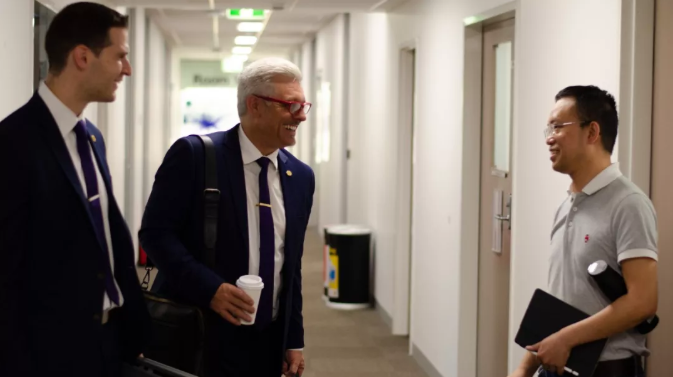
HCASH checking in: An Interview with Dr Joseph Liu

Recently, members of HCASH including CEO (Chief Executive Officer) Adam Geri and COO (Chief Operations Officer) Andrew Wasylewicz visited Monash University to touch base with Dr Joseph Liu, see how his work at the laboratory has been progressing and to get answers regarding some questions raised by the HCASH community.
After initial pleasantries were had, Dr Liu informed the pair that within the last 24 hours, he had received a ‘researcher’ of the year award from the ACS (Australian Computer Society), a highly respected and professional association with over 26,000 members regarding his previously submitted research paper that focuses on privacy-preserving algorithms that can be implemented in Blockchain networks. He was thrilled with the result and is happy in the way that Blockchain technology is progressing.
So far, the privacy-preserving protocols outlined in the ACS paper are still being researched, however, once completed, they can be implemented in HCASH.
Regarding questions from the community, in a Q&A style format, the pair asked the following questions:
Question #1
What does your team focus on each day?
Answer
Regarding day-to-day research, our team mainly focuses on anything relating to privacy-preserving protocols, security and consensus mechanisms. To aid this, in September a new lecturer joined us who happens to be an expert in Blockchain consensus technology, so we’re excited to have someone like that.
Question #2
Any upcoming news or plans regarding the research lab?
Answer
Yes, actually. Since its submission to the ACS, the algorithm presented in the paper that received the award has been improved upon, and recently we’ve submitted a technical paper to another conference, which represents the improvements we’ve made. Essentially, the difference with this improved algorithm compared to the one released at ACS is that it allows people to operate multiple wallets, rather than merely one, which reduces transaction fees and generally increases system efficiency.
Question #3
Could you tell us about the team and where you could see Blockchain technology being applied to?
Answer
So far we have 6 academics working on the project, with our specialities ranging from fundamental blockchain research, application research and niche cryptographic functions. All of us here firmly believe that Blockchain technology has some application in all sectors in the economy and in fact, we’re actively in collaborative talks to try to combine members of our faculty with others from the energy and medical research sectors to help them improve efficiency.
Question #4
How could Blockchain technology be applied to energy systems?
Answer
Really, we’re talking about new SmartWare energy systems that we’ll be seeing more of in the future. These systems generate information which needs to be preserved and protected (such as information regarding your power consumption, peak usage times, trough usage times, and the amount of energy you’re generating — if you have solar). Thus, when considering this, Blockchain can be a great tool to keep this data secure.
Question #5
What makes your quantum resistance signature scheme implementation superior to others, such as Rainbow?
Answer
Great question. To answer this, we need to review exactly what is needed in a secure blockchain system, which is a hash function and a digital signature. In a Blockchain network, the hash function is secure against a quantum attack, but the digital signature is not, thus this signature scheme is vulnerable and that’s why in HCASH we have focused on fixing this weakness. Often security and efficiency contradict each other, and each is easy to achieve without the other. This can be seen in many other signature solutions that exist, some of which can take several days to process one transaction. This is why we’ve developed our algorithm and why HCASH is important because we’ve managed to create what we believe is a good scheme, particularly one that is highly practical by being both as secure and efficient as we can make it, without sacrificing the integrity of either.
Question #6
What do you see as the future central issues relating to the development of Blockchain technology?
Answer
I see quantum resistance and storage mechanisms being partly central to its development. Considering we’ve already discussed quantum resistance, I’ll discuss storage issues. Really, the issue concentrates on how to query data from a Blockchain. Right now, users can place tons of information on a blockchain, but finding specific stored data can take large amounts of time as you’ll need to search from the first to the last block for your information. Thus, our laboratory is currently doing additional research into off-chain storage systems accompanied by an on-chain system to facilitate efficiency in searching and privacy in the blockchain; another example of an optimal trade-off.
Question #7
Why is it important to keep building new Blockchain platforms, rather than develop on legacy networks (such as Bitcoin and Ethereum)?
Answer
Everyone knows that Bitcoin is the first Blockchain network, and people may have questions asking, ‘why do we need to have multiple cryptocurrencies?’ This is because Bitcoin itself, while the first, is not the best. There is a large amount of functionality to improve upon, however, it’s quite hard to simply improve on Bitcoin and reach consensus to implement innovations. Through different networks that have been created, for example, Ethereum for Smart Contracts and HCASH for post-quantum security, we see that it is much easier to create your own network and innovate on it, rather than to update legacy systems.

In conclusion, it’s clear to see that big things are happening at the Monash Blockchain research laboratory and that with Dr Joseph Liu guiding our privacy-preserving, security and consensus mechanism research, we’re in well-equipped hands.
